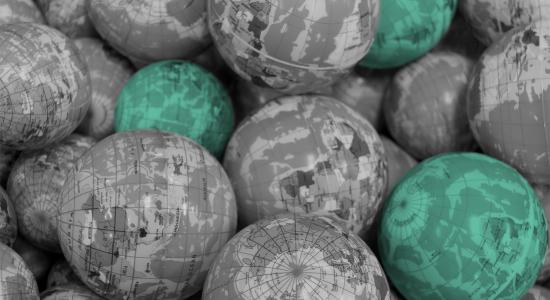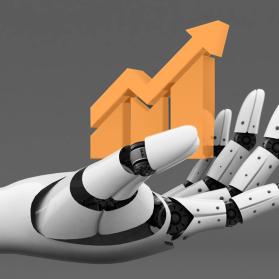Artificial intelligence and data analytics have the potential to support the sustainable management of the environment and society. They currently act primarily as drivers of sustainability, as their application has a significant impact on reducing energy consumption. Implementable solutions already exist in many areas.
Hardly a day goes by without encountering the term sustainability in its ecological, economic or social dimension: Be it in the media, for example in reports on increasing droughts and floods worldwide, or in our private and professional environment in activities and discussions on climate protection activities.
AI as a future field - also for sustainability
Artificial intelligence (AI) and data analytics have the potential to support us in dealing with our environment and society in a sustainable manner - and in many areas: for example, in saving resources, energy and CO2 emissions, but also in providing services of general interest in the form of a functioning infrastructure. The interaction of sustainability and AI as well as data analytics is therefore considered an important future field.
In terms of environmental sustainability, a study estimates that the use of AI for environmental protection measures in the 4 sectors of agriculture, water, energy and transport could contribute up to US$5.2 trillion to the global economy in 2030. At the same time, the application of AI measures in these sectors could reduce global greenhouse gas emissions by 4 percent by 2030. This would equate to a reduction of 2.4 gigatons of CO2 emissions.
Start-up scene already focuses on solutions for specific challenges
Many start-ups and research institutions, as well as established companies, are already researching and consulting on AI/data analytics and sustainability and are bringing innovative products and solutions to the market.
In the start-up sector, a Detecon screening showed that about 390 international start-ups and young companies are developing individual AI solutions which pay attention to sustainability aspects. Many of them focus on solutions for specific challenges and address very different business areas.
For example, Inceptio from China wants to offer a nationwide freight network for autonomously driving trucks. An algorithm that analyzes truck and driver pool matches, among other things, optimizes load factors, fuel consumption and empty runs. Accedian, a French network service provider, optimizes networks and capacity planning at all levels by putting network components to sleep when they are not needed.
In the area of research, Detecon identified about 30 universities, research institutes and corporate research facilities. The activities focus primarily on the areas of facility management, customer service, mobility/fleet management and product management.
Sustainable AI or AI as a driver for sustainability? Both!
Detecon has also been active in the combination field of AI and sustainability for several years and within many customer projects. We see two exciting potentials for the future in the bridge between AI as a technology and the topic of sustainability:
- Support of sustainability by means of AI. In this context, AI acts as a driver and enabler.
- Support of sustainable AI by means of innovative digitization solutions.
AI can bring positive effects to sustainable development in various business fields:
Application of AI has a significant effect on reducing energy consumption. An intelligent infrastructure can use predictive modeling for tangible consumption forecasts, digital twins for detection of synergies and smart design and smart sensors and actuators to increase customer experience and efficiency at lower consumption. Through renewable energy, smart grid, intelligent traffic management, intelligent water management, sustainable healthcare infrastructure, green buildings, etc., each part of a city can be thoroughly connected and controlled automatically.
Examples of sustainable AI use from different industries
AI can also be used in the telecommunications sector to optimize routing, implement least-cost routing, assist with fault management or to detect customer traffic patterns. With these advanced algorithms to look for patterns within the data, telcos are enabled to both detect and predict network anomalies and allowing them to proactively fix problems before customers are negatively impacted. Such self-optimizing networks increase the efficiency and optimize the energy consumption as well.
AI can vastly improve the efficiency of urban transportation networks by collecting and analyzing the data on the movement of people, the underlying demand, and the varying patterns of that demand, which are the critical data bases to conduct intelligent solutions. A optimized transportation network can not only reduce traffic congestion (associated with redundant energy consumption and emission), but also increase the supply chain logistics by autonomous fleets. Smart analytics provides the system with accurate forecasting for the demands, which helps operating on minimal transportation expenses.
With simulation of a supply chain and lifetime analysis in waste management, closed-loop looks to keep materials engaged in a circular way, recycled and reused throughout rather than used once and turned into waste. This concept is strongly connected with zero waste, where is the conservation of all resources by means of responsible production, consumption, reuse, and recovery of all products, packaging, and materials without burning them and without discharges to land, water, or air that threaten the environment or human health. The societal sustainable impact is profound.
As for consumers, smart home vastly increase the quality of life and living, operational and burglary security and energy efficiency, which has both economic, ecological and social implications. Examples are automatically controlled heating, ventilation, doors, windows, awnings, blinds and lamps (building or home automation) as well as systems that can be controlled and manipulated manually via mobile devices. With recommendation engines and pattern recognition, connected life services such as smart home deliveries, automatic replenishment services, and conversational interfaces can be embedded in a smart home as well.
Define your company-specific sustainability priorities
As these examples show, AI is established in various areas and a variety of solutions are already applicable. Increasingly ambitious regulations and goals in the area of sustainability are also forcing companies to take action. But how to combine the two?
The highly diversified landscape of startups shows how multifaceted the topic is. Companies must therefore focus and define their own sustainability priorities. Suggestions for this are provided, among other things, by various research areas, which can serve as an aid in deriving one's own goals.
Furthermore, companies should not neglect the technological perspective, which is essential in the design. The possible implementation of different use cases with the help of AI does not automatically mean that the implementation also pays into the sustainability goals. Interactions between, for example, energy consumption through the application of AI and the holistic sustainability effect it creates must be weighed. Accordingly, we need to ensure that both technical assessments, but also business concerns such as responding to regulations, are linked to efficiently achieve sustainability goals.
Are you currently facing just this challenge? Feel free to contact us.
Co-authors of the article are Yanglingzi Wang and Michael Philipp Schroeder.









